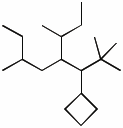Organic Chemistry I |
Exam 1 |
Professor Carl C. Wamser |
![]()
Organic Chemistry I |
Exam 1 |
Professor Carl C. Wamser |
![]()
1. (15 points) Write complete names for each of the following.
a) ![]()
b) 
c) 
2. (15 points) Write accurate structures for the following:
a) the isomer of C5H12 with the highest heat of combustion
b) a C4 compound that contains both sp2 and sp hybridized carbons
c) the best resonance form for CH3N2+
(show all bonds, lone pairs, and formal charges)
d) 2,2,6,6-tetramethylbicyclo[2.2.1]heptane
e) 1,5-dimethylspiro[2.3]hexane
3. (10 points) Squaric acid is a relatively strong acid.
Show three resonance forms for the anion that is formed when squaric acid loses a proton.

4. (14 points) Complete each of the following acid-base reactions. Identify the pKa values of the acids on each side of the equation and predict the preferred direction of the equilibrium.
a) ![]()
b) ![]()
c) ![]()
d) ![]()
Of all the compounds cited above (on both sides of the equations), which is the strongest acid?
Which is the strongest base?
5. (15 points) Based on the Newman diagram below, write the structure of this compound in a line structure. Show the proper location of all six of the substituents shown on the Newman diagram on the line structure using appropriate wedge or dashed lines.
Give a complete name for the compound - ignoring stereochemistry issues.
6. (15 points) Write both chair forms for trans-1-ethyl-3-methylcyclohexane.
The energy difference between axial and equatorial for methyl is 7 kJ/mol and for ethyl it is 8 kJ/mol.
Predict which is the preferred conformation of trans-1-ethyl-3-methylcyclohexane.
What would be the predicted energy difference between the two conformations?
7. (16 points) Write Newman diagrams for all three staggered conformations of 1-bromo-2-methylbutane, looking down the C1-C2 bond.
Identify the relative energies of the three forms.
Write Newman diagrams for all three staggered conformations of the same compound, 1-bromo-2-methylbutane, looking down the C2-C3 bond.
Identify the relative energies of the three forms.
Using both of the preferred conformations from the above, draw a line structure that shows the overall best conformation of 1-bromo-2-methylbutane.
Use wedges and dashes as needed to show substituent locations (not including hydrogens).
![]()